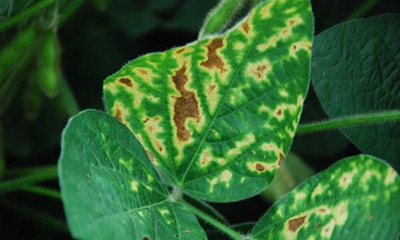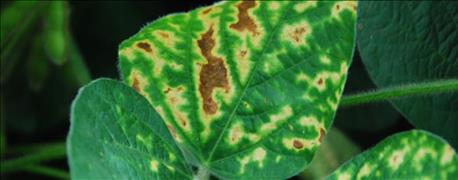March 21, 2016

We’re told that protecting soybean yields from sudden death syndrome starts with seed selection. That’s not entirely true. Protecting soybeans starts with breeders evaluating genetic lines.
“Soybean breeding companies evaluate their germplasm sources for the best genetic resistance, then you incorporate those into their breeding material,” says Doug Tigges, soybean genetic product manager at Syngenta. “At Syngenta, our Y.E.S. Yield Engineering System, which incorporates marker-assisted breeding, allows breeders to make smarter, more informed decisions when developing NK Soybean varieties.”

SDS SYMPTOMS: Cool, moist conditions early in the growing season often result in higher incidence of sudden death syndrome in soybeans. Favorable disease conditions may result from early planting, high rainfall and /or low-lying, poorly drained or compacted field areas.
Planting beans with genetic resistance to SDS really helps
Syngenta researchers use state-of-the-art molecular marker technology in conjunction with other breeding tools and processes to identify which and how many crosses will result in the highest-yielding progeny with traits tailored to specific environmental conditions. Researchers target traits that improve soybeans’ resilience and yield potential, helping them overcome agronomic obstacles like SDS. With these tools, new, improved varieties can be in growers’ hands in half the time.
“Planting soybean varieties with genetic resistance to SDS helps control this disease without costing the grower extra money,” says Randy Kool, agronomic service representative at Syngenta. “As SDS advances on the list of yield robbers, growers need to select varieties with strong resistance ratings in addition to the other traits they need.”
If SCN is also a problem in a field, SDS disease may be more severe
With an average 1.5-point advantage in SDS resistance, NK Soybean varieties offer the best SDS ratings in relative maturity groups 1.5 to 4.5 on the market, says Kool. Even with the best breeding processes, no variety is totally resistant to SDS, so growers still need to practice sound management strategies.
“Planting early has yield benefits,” Kool says, “but cool, moist soil makes soybeans more susceptible to SDS. Fields with a history of SDS should be planted last, when we’re nearing warmer, drier conditions. If soybean cyst nematode is in a field, the damage from SDS will be increased, so a grower would want to consider planting a SCN resistant variety and also use a seed treatment that has activity on SCN.”

Syngenta and Monsanto use the same SDS rating scale of: 1 = Excellent and 9 = Poor. The DuPont Pioneer scale of 9 = Excellent and 1= Poor was translated to the Syngenta and Monsanto scale for the analysis.
You May Also Like




